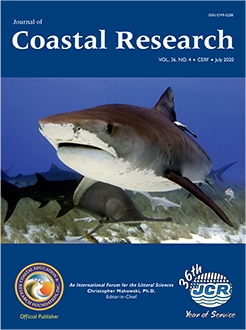Chiba, T. and Nishimura, Y., 2020. Using diatom assemblages to infer topographical changes from storm-induced sandbar breaching in Horokayanto Lagoon, Hokkaido, Japan. Journal of Coastal Research, 36(4), 720–731. Coconut Creek (Florida), ISSN 0749-0208.
The sandbar of Horokayanto Lagoon, a sandbar-fronted lagoon on the coast of eastern Hokkaido, Japan, was partly breached, and the bottom was partly exposed during severe weather in June 2016. After the breach, the mean lagoon level fell to about 1.2 m above Tokyo Peil, equivalent to the height of the mean higher-high tide level. Field surveys were conducted on 2, 23, and 30 June 2016 to examine topographical changes in the Horokayanto area. Four diatom-assemblage groups were identified from samples collected during this fieldwork: marsh, emerged lagoon bottom, lagoon bottom, and seashore groups. The assemblages showed good consistency with the salinity and sediment properties at each location. The high-tide-level indicator Pseudopodosira kosugii was recognized in the emerged lagoon-bottom assemblage, together with freshwater–brackish and brackish–marine species. Living P. kosugii colonies had previously been recognized only in the lower reaches of the Obitsu River, Chiba Prefecture, Japan, although the species is widespread in Holocene sediments in Japan and other countries. Reworked Neogene diatoms were also detected in the assemblages. These diatoms were presumably derived from nearby Neogene basement rocks, such as the Taiki Formation, which were eroded by current inflow into the lagoon during the severe weather. During the period of emergence, seawater might have been transported into Horokayanto Lagoon by high waves generated by an atmospheric low-pressure system. Water pressure or moisture changes caused by the emergence, changes in light quantum density and ultraviolet rays, or changes in water quality, such as in salinity and pH, or a mixture of these factors, may have influenced the increase in abundance of P. kosugii.





